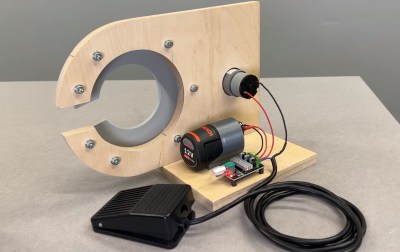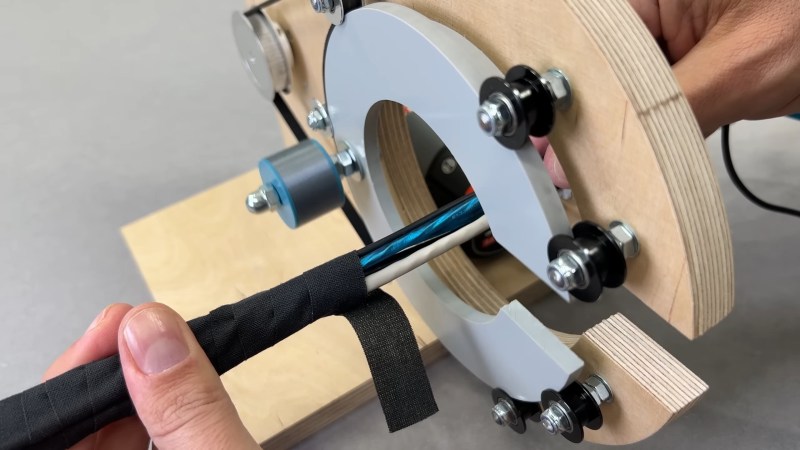If you’re making a lot of wiring harnesses, wrapping them can become a bit of a drag. [Well Done Tips] wanted to make this process easier and built a wiring harness wrapping machine.
 The “C” shape of this wrapping machine means that you can wrap wires that are still attached at one or both ends, as you don’t have to pull the wires all the way through the machine. The plastic “C” rotates inside a series of pulleys with three of them driven by a belt attached to an electric motor. A foot pedal actuates the motor and speed is controlled by a rotary dial on the motor controller board.
The “C” shape of this wrapping machine means that you can wrap wires that are still attached at one or both ends, as you don’t have to pull the wires all the way through the machine. The plastic “C” rotates inside a series of pulleys with three of them driven by a belt attached to an electric motor. A foot pedal actuates the motor and speed is controlled by a rotary dial on the motor controller board.
Since this is battery powered, you could wrap wires virtually anywhere without needing to be near a wall outlet. This little machine seems like it would be really great if you need to wrap a ton of wire and shouldn’t be too complicated to build. Those are some of our favorite hacks.
If you’re wanting more wire harness fun, try this simple online wiring harness tool or see how the automotive industry handles harnesses.
















Love the idea, and I love the video, it has a timelapsy feel to it. Also, neat trick of using a compass tracing the inside of a circle.
Watched it based on your comment, and wasn’t disappointed. First time I’ve seen this style of editing, and I like it!
Neat idea, could also be used for windind large toroids.
ECACTLY my first thought.
Nice build. I’d say he should add some tension on that tape/wrap.
Just a quick note on the linked “simple online wiring harness tool” (Wirely):
Since it is based on the open-source WireViz project, but does not currently include any attribution as per GPL (as of this writing), I think it would be fair to mention the original WireViz project in this article as well :-)
https://github.com/formatc1702/WireViz
I’m glad to see this comment. Somehow I missed when Wirely made the rounds in July. At first glance, Wirely doesn’t do *that much* more than WireViz itself. The original YAML becomes JSON and only slightly abstracted through the tree structure.
My eyes lit up seeing an alternate implementation of Wirely, hoping for something more WYSIWYG/GUI-flavored. I don’t do much with YAML/XAML/JSON, but I imagine there are some VS Code plugins to give the collapsible trees that seem to be the biggest add with Wirely.
Monetizing WireViz without even an attribution, with only marginal added utility, that’s definitely worth a callout.
I think I’d have added a leaf switch or used a light sensor to detect the position of the inner C shaped section, holding the power on until it’s aligned. A bit like auto homing windscreen wipers on cars. That way you wouldn’t need to be so precise when you stop it rotating.
Is avoiding adjusting the position carefully by hand really bad enough that the added complexity is worth it? I know hand turning an electric motor can generate small power spikes, but as I understand it as long as you do it slowly simple circuits like this are unlikely to be at risk.
I realize this is probably a heavily opinion/usage based question, if someone has everything they need laying around & has done similar circuits so it’s second nature or if you’re planning to use a rig like this on like a car or airplane’s worth of wiring bundles then avoiding the tiny bit of manual work might totally make sense
If you use it once per day every handful of weeks, then aligning by hand is probably not worth it. If you’re wrapping several harnesses in one go, you’d probably make it through 3 or 4 before really wishing you didn’t have the fiddle with the rig every time.
It’s easily done. As said mount the switch (micro-switch is adequate) to detect the gap in the plastic disc, and wire it in series with the motor. This micro-switch controls the motor; so switch open, motor off (i.e. at the gap).
The foot switch is then wired across the micro-switch to short it, causing the motor to run. As the disc body keeps the switch closed, the motor will run even if the foot switch is opened, but will stop when the disc gap reaches the micro-switch and opens it.
One extra part, a minor bit of thinking over where to mount it, and you’ll never have to “tap tap tap tap doh” the foot switch trying to line up the gap ever again.
So many people dismiss stuff like this that turns an adequate tool into a great one. Reminds me of the Mythbusters bit where Adam is complaining about Jamie’s vacuum former. A few niceties goes a long way.
once watched them use a tool just like this on the fiber optic cable bundle strung up between two telephone poles in front of my house. they just drove the bucket truck along under the wire and the guy in the bucket dragged this tool along the wire. i’m not sure but i think it was actually powered by the dragging motion…the tension on the wrapping wire somehow caused it to rotate. always kind of a trip to see a truck moving with the bucket extended!
It’s called a “lasher”
There a J model and a C model
Easier to use split loom tubing. 100% more serviceability friendly (vs. trying to remove gunked up tape!)
To each his own. It’s getting harder to find local suppliers, and shipping gets prohibitive, especially in the sticks where i live. Tape is cheap and easily obtainable; I buy it in 10 packs at Harbor Freight, at obscenely low prices.
Tape is cheap. Servicing the sticky mess is someone else’s problem.
(Although he’s using that fancy cloth tape, ooh la de da.)
Clever design. As an iteration for the next version I would look into replacing the foot pedal switch with a sewing machine pedal. That would give speed control to the foot pedal allowing both hands to concentrate on managing the wire bundle.